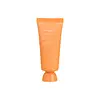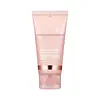What's inside
What's inside
 Key Ingredients
Key Ingredients

 Benefits
Benefits

 Concerns
Concerns

No concerns
 Ingredients Side-by-side
Ingredients Side-by-side

Water
Skin ConditioningButylene Glycol
HumectantGlycerin
HumectantCetyl Ethylhexanoate
Emollient1,2-Hexanediol
Skin ConditioningSqualane
EmollientButyrospermum Parkii Butter
Skin ConditioningDi-C12-13 Alkyl Malate
EmollientCyclopentasiloxane
EmollientDimethicone
EmollientGlyceryl Stearate
EmollientCyclohexasiloxane
EmollientTrehalose
HumectantC14-22 Alcohols
Emulsion StabilisingPalmitic Acid
EmollientStearic Acid
CleansingCetearyl Alcohol
EmollientHydrogenated Castor Oil Isostearate
Skin ConditioningHydroxypropyl Starch Phosphate
PEG-100 Stearate
Dimethicone/Vinyl Dimethicone Crosspolymer
Skin ConditioningC12-20 Alkyl Glucoside
EmulsifyingPolyacrylate-13
Phytosteryl/Behenyl/Octyldodecyl Lauroyl Glutamate
Skin ConditioningC12-16 Alcohols
EmollientAcrylates/C10-30 Alkyl Acrylate Crosspolymer
Emulsion StabilisingTromethamine
BufferingParfum
MaskingXanthan Gum
EmulsifyingZiziphus Jujuba Fruit Extract
Skin ConditioningGlyceryl Caprylate
EmollientJuglans Regia Seed Extract
Skin ConditioningLimonene
PerfumingPolyisobutene
Scutellaria Baicalensis Root Extract
AstringentHydrogenated Lecithin
EmulsifyingMorus Alba Root Extract
BleachingDisodium EDTA
Ethylhexylglycerin
Skin ConditioningDextrin
AbsorbentTheobroma Cacao Extract
Skin ConditioningHoney
HumectantLinalool
PerfumingPolysorbate 20
EmulsifyingNelumbo Nucifera Flower Extract
Skin ConditioningPolygonatum Officinale Rhizome/Root Extract
Skin ConditioningRehmannia Glutinosa Root Extract
Skin ConditioningPaeonia Albiflora Root Extract
Skin ConditioningLilium Candidum Bulb Extract
Skin ConditioningSorbitan Isostearate
EmulsifyingPanax Ginseng Root Extract
EmollientPunica Granatum Fruit Extract
AntioxidantPropanediol
SolventCitronellol
PerfumingCitral
PerfumingGeraniol
PerfumingMyristic Acid
CleansingArachidic Acid
CleansingGlucose
HumectantBenzyl Benzoate
AntimicrobialGlycyrrhiza Uralensis Root Extract
Skin ConditioningTocopherol
AntioxidantPunica Granatum Flower Extract
Skin ConditioningWater, Butylene Glycol, Glycerin, Cetyl Ethylhexanoate, 1,2-Hexanediol, Squalane, Butyrospermum Parkii Butter, Di-C12-13 Alkyl Malate, Cyclopentasiloxane, Dimethicone, Glyceryl Stearate, Cyclohexasiloxane, Trehalose, C14-22 Alcohols, Palmitic Acid, Stearic Acid, Cetearyl Alcohol, Hydrogenated Castor Oil Isostearate, Hydroxypropyl Starch Phosphate, PEG-100 Stearate, Dimethicone/Vinyl Dimethicone Crosspolymer, C12-20 Alkyl Glucoside, Polyacrylate-13, Phytosteryl/Behenyl/Octyldodecyl Lauroyl Glutamate, C12-16 Alcohols, Acrylates/C10-30 Alkyl Acrylate Crosspolymer, Tromethamine, Parfum, Xanthan Gum, Ziziphus Jujuba Fruit Extract, Glyceryl Caprylate, Juglans Regia Seed Extract, Limonene, Polyisobutene, Scutellaria Baicalensis Root Extract, Hydrogenated Lecithin, Morus Alba Root Extract, Disodium EDTA, Ethylhexylglycerin, Dextrin, Theobroma Cacao Extract, Honey, Linalool, Polysorbate 20, Nelumbo Nucifera Flower Extract, Polygonatum Officinale Rhizome/Root Extract, Rehmannia Glutinosa Root Extract, Paeonia Albiflora Root Extract, Lilium Candidum Bulb Extract, Sorbitan Isostearate, Panax Ginseng Root Extract, Punica Granatum Fruit Extract, Propanediol, Citronellol, Citral, Geraniol, Myristic Acid, Arachidic Acid, Glucose, Benzyl Benzoate, Glycyrrhiza Uralensis Root Extract, Tocopherol, Punica Granatum Flower Extract
Water
Skin ConditioningPolyvinyl Alcohol
Glycerin
HumectantAgave Americana Stem Extract
Skin ConditioningSodium Hyaluronate
Humectant1,2-Hexanediol
Skin ConditioningCaprylyl Glycol
EmollientPolyglyceryl-10 Laurate
Skin ConditioningChlorella Vulgaris Extract
Skin ConditioningGlucose
HumectantButylene Glycol
HumectantEthylhexylglycerin
Skin ConditioningFructooligosaccharides
HumectantFructose
HumectantXanthan Gum
EmulsifyingCynanchum Atratum Extract
Skin ConditioningCaprylic/Capric Triglyceride
MaskingHydrogenated Lecithin
EmulsifyingAlthaea Rosea Flower Extract
Skin ConditioningCeramide NP
Skin ConditioningTocopherol
AntioxidantPancratium Maritimum Extract
BleachingCollagen Extract
Skin ConditioningSodium Stearoyl Glutamate
CleansingWater, Polyvinyl Alcohol, Glycerin, Agave Americana Stem Extract, Sodium Hyaluronate, 1,2-Hexanediol, Caprylyl Glycol, Polyglyceryl-10 Laurate, Chlorella Vulgaris Extract, Glucose, Butylene Glycol, Ethylhexylglycerin, Fructooligosaccharides, Fructose, Xanthan Gum, Cynanchum Atratum Extract, Caprylic/Capric Triglyceride, Hydrogenated Lecithin, Althaea Rosea Flower Extract, Ceramide NP, Tocopherol, Pancratium Maritimum Extract, Collagen Extract, Sodium Stearoyl Glutamate
 Reviews
Reviews

Ingredients Explained
These ingredients are found in both products.
Ingredients higher up in an ingredient list are typically present in a larger amount.
1,2-Hexanediol is a synthetic liquid and another multi-functional powerhouse.
It is a:
- Humectant, drawing moisture into the skin
- Emollient, helping to soften skin
- Solvent, dispersing and stabilizing formulas
- Preservative booster, enhancing the antimicrobial activity of other preservatives
Butylene Glycol (or BG) is used within cosmetic products for a few different reasons:
Overall, Butylene Glycol is a safe and well-rounded ingredient that works well with other ingredients.
Though this ingredient works well with most skin types, some people with sensitive skin may experience a reaction such as allergic rashes, closed comedones, or itchiness.
Learn more about Butylene GlycolEthylhexylglycerin (we can't pronounce this either) is commonly used as a preservative and skin softener. It is derived from glyceryl.
You might see Ethylhexylglycerin often paired with other preservatives such as phenoxyethanol. Ethylhexylglycerin has been found to increase the effectiveness of these other preservatives.
Glucose is a simple sugar and is the most important source of energy in all organisms.
In skincare, glucose is used to hydrate the skin. It also acts as a prebiotic for our natural biome.
Glucose is hydrating due to its humectant property. As a humectant, glucose draws moisture from the air and from deeper levels in the skin.
Our skin contains many sugars that act as prebiotics and help strengthen our natural microbiome. Having a healthy microbiome helps protect our skin from harmful bacteria and other contaminants.
Studies show glucose may help with fading discoloration and pigmentation. This is because our skin metabolizes glucose into lactic acid. Lactic acid is an AHA that helps exfoliate the top layer of skin.
Learn more about GlucoseGlycerin is already naturally found in your skin. It helps moisturize and protect your skin.
A study from 2016 found glycerin to be more effective as a humectant than AHAs and hyaluronic acid.
As a humectant, it helps the skin stay hydrated by pulling moisture to your skin. The low molecular weight of glycerin allows it to pull moisture into the deeper layers of your skin.
Hydrated skin improves your skin barrier; Your skin barrier helps protect against irritants and bacteria.
Glycerin has also been found to have antimicrobial and antiviral properties. Due to these properties, glycerin is often used in wound and burn treatments.
In cosmetics, glycerin is usually derived from plants such as soybean or palm. However, it can also be sourced from animals, such as tallow or animal fat.
This ingredient is organic, colorless, odorless, and non-toxic.
Glycerin is the name for this ingredient in American English. British English uses Glycerol/Glycerine.
Learn more about GlycerinHydrogenated Lecithin is created from the hydrogenation of lecithin (a group of phospholipids). Hydrogenation is a chemical reaction between hydrogen and another element.
This ingredient is an emollient and emulsifier. As an emollient, it helps soften skin by trapping moisture within. As an emulsifier, it prevents oil and water ingredients from separating.
Tocopherol (also known as Vitamin E) is a common antioxidant used to help protect the skin from free-radicals and strengthen the skin barrier. It's also fat soluble - this means our skin is great at absorbing it.
Vitamin E also helps keep your natural skin lipids healthy. Your lipid skin barrier naturally consists of lipids, ceramides, and fatty acids. Vitamin E offers extra protection for your skin’s lipid barrier, keeping your skin healthy and nourished.
Another benefit is a bit of UV protection. Vitamin E helps reduce the damage caused by UVB rays. (It should not replace your sunscreen). Combining it with Vitamin C can decrease sunburned cells and hyperpigmentation after UV exposure.
You might have noticed Vitamin E + C often paired together. This is because it is great at stabilizing Vitamin C. Using the two together helps increase the effectiveness of both ingredients.
There are often claims that Vitamin E can reduce/prevent scarring, but these claims haven't been confirmed by scientific research.
Learn more about TocopherolWater. It's the most common cosmetic ingredient of all. You'll usually see it at the top of ingredient lists, meaning that it makes up the largest part of the product.
So why is it so popular? Water most often acts as a solvent - this means that it helps dissolve other ingredients into the formulation.
You'll also recognize water as that liquid we all need to stay alive. If you see this, drink a glass of water. Stay hydrated!
Learn more about WaterXanthan gum is used as a stabilizer and thickener within cosmetic products. It helps give products a sticky, thick feeling - preventing them from being too runny.
On the technical side of things, xanthan gum is a polysaccharide - a combination consisting of multiple sugar molecules bonded together.
Xanthan gum is a pretty common and great ingredient. It is a natural, non-toxic, non-irritating ingredient that is also commonly used in food products.
Learn more about Xanthan Gum